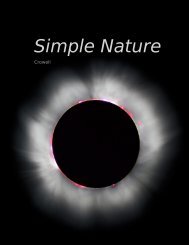Chapter 3 Acceleration and free fall - Light and Matter
Chapter 3 Acceleration and free fall - Light and Matter
Chapter 3 Acceleration and free fall - Light and Matter
Create successful ePaper yourself
Turn your PDF publications into a flip-book with our unique Google optimized e-Paper software.
150 <strong>Chapter</strong> 4 Force <strong>and</strong> motion<br />
could accelerate an object continuously until it was moving faster<br />
than the speed of light (relative to us). But this can’t be so, because<br />
we’ve seen in section 2.6 that relativity forbids objects from moving<br />
relative to one another at speeds faster than the speed of light. We<br />
will see in section 14.7 that an object’s inertia F/a is larger for an<br />
object moving closer to the speed of light (relative to the observer<br />
who measures F <strong>and</strong> a). It is not equal to a constant m as claimed<br />
by the second law. These variations in inertia have been measured<br />
experimentally, <strong>and</strong> they can be huge — as much as a factor of<br />
3 × 10 11 for a cosmic ray detected in the sky over Utah in 1994. 4<br />
The second law is nevertheless highly accurate within its domain of<br />
validity, i.e., small relative speeds.<br />
The second law also fails at the microscopic level because particles<br />
are not just particles, they’re also waves. One consequence of<br />
their wavelike nature is that they do not have exactly well defined<br />
positions, so that the acceleration a appearing in a = F/m is not<br />
even well defined.<br />
4 Bird et al., http://arxiv.org/abs/astro-ph/9410067v1














